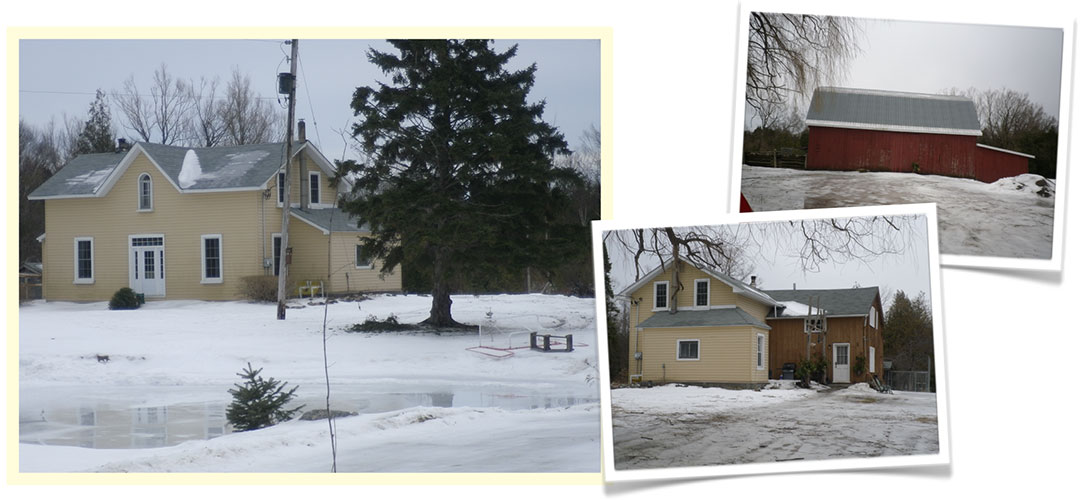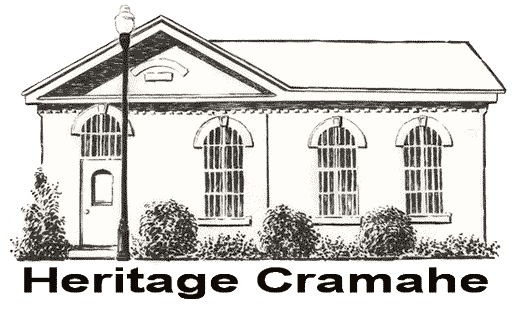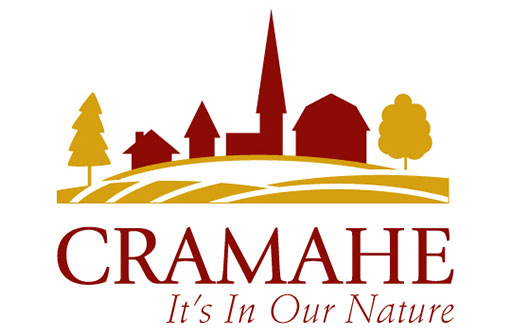221 Orchard Road, Colborne
(1850s)
Roll No. 1411-011-010-18300 – Cramahe Township Ontario

Ontario Farmhouse – Designated
The Fannin house is a designated property situated at 221 Orchard Road in the village of Colborne. It is a three bay, one and a half story house, built in the Gothic Revival cottage style with a centre gable.
This house is estimated to have been built in approximately the 1850s.
It was originally built with a brick veneer exterior and a wrap around porch, however the porch and most of the brick is now missing. The house is notable for its front entrance consisting of the original door with three long panels over three. There is a three pane sidelight on each side and a four pane overhead transom. The two sidelights retain their original storm windows. The house also has its original six over six sash and interior moulded window trim. One of the best features of the house is its upstairs centre hall dormer with
fan light window over two swing-in multi-pane windows.
The west side of the house was once flanked on both sides by a number of large maple trees. There is a man made pond in front of the house and it sits on an acreage just at the Northern edge of the village of Colborne.
There is a weathered barn just behind the house.
Today the house is covered in yellow siding with wood board and batten on the rear two story “tail”.
History or Associative Value
The census has Thomas Draper living on this property in 1804, probably in a log cabin. He fought for the Loyalists in the American revolutionary war and was captured at the Battle of Bennington in 1777. He was tried for treason but was mysteriously released and he then moved to Cramahe Township before 1803. Draper and wife Lydia had 13 children, all of whom were born in the American colonies. G. Sanderson lived here 1854-1902 when he retired to 8 North Street, another of Cramahe’s designated properties.
Additional Historical and Genealogical Information
The Crown granted the 200 acres in Concession 2, Lot 34 to Thomas Everton on 2 May 1807. Little has been found about Everton, except that he was supposedly the clerk of the First Baptist Church of Cramahe and Haldimand Townships in 1794. If this date is accurate, he must have been one of the very earliest settlers in the area. After all, Joseph Keeler’s first group arrived just the year before, in 1793. There was a Thomas Everton (1762-1843) of the right vintage who was a deacon in the Baptist Church in Meigs Co., Ohio, in the mid 1810’s (after our Thomas Everton disappeared from Cramahe). It is possible this is the same man, but this is unlikely since the Ohio Everton fought for the Americans in the Revolutionary War. It is doubtful, given that fact, that he would have gone to Ohio by way of British Canada.
On 21 July 1809 the northern 75 acres of Concession 2, Lot 34 were purchased from Everton by Thomas Draper (1739-1817), who had been living there since at least 1804. Draper was born in Newton, Massachusetts, in 1739. He moved to Dutchess Co., New York (by way of Rhode Island), and married Lydia Rogers (1751-1807) there in 1768. He fought for the Loyalists in the Revolution, and was captured at the Battle of Bennington, Massachusetts in 1777, after which he was tried for treason but released. He applied for land as an Empire Loyalist in Quebec in 1786 but was unsuccessful. In 1797 he was a resident of Albany, New York, and moved to Cramahe Township before 1803. One genealogy states that he “was after land of Thomas Everton, not final until filed 21 July 1809, but he is on 1804 Cramahe Township census, listed as living on that property, Lot 34, 2nd Concession”. It is unclear what “was after land of Thomas Everton” means. It sounds sort of nefarious, but maybe that is just the way the genealogist worded it and it doesn’t mean anything in particular.
Draper had 13 children: Thomas (b. 1769), Lydia (b. 1772), William (b. 1774), Carson (b. 1776), Nancy and Mercy (twins b. 1778), Patience (b. 1781), Olive (b. 1783), Mary (b. 1786), Clark (b. 1791), Joel and Lucretia (twins b. 1794-1795), and Charles (b. 1797). All of these children were born in the United States before their father immigrated to Canada. Which, if any, accompanied him to Cramahe Township, and therefore likely resided on Concession 2, Lot 34? The following tables list the ages of the Draper family members (Thomas excluded) who were present for several early Cramahe censuses, and the ages the children would have been when those censuses were taken.
Censuses:
| Year | M>16 | F>16 | M<16 | F<16 | Total |
|---|---|---|---|---|---|
| 1804 | 0 | 1 | 2 | 1 | 4 |
| 1805 | 0 | 0 | 2 | 1 | 4 |
| 1807 | 1 | 0 | 1 | 0 | 3 |
| 1810 | 0 | 1 | 0 | 0 | 2 |
| 1813 | 0 | 1 | 0 | 0 | 2 |
| 1815 | 0 | 0 | 0 | 0 | 1 |
| 1817 | 1 | * | 1 | * | 4 |
*Two females total in 1817, ages not recorded.
Children’s Ages
| Name | 1804 | 1805 | 1807 | 1810 | 1813 | 1805 | 1817 |
|---|---|---|---|---|---|---|---|
| Thomas | 35 | 36 | 38 | 41 | 44 | 46 | 48 |
| Lydia | 31 | 32 | 34 | 37 | 40 | 42 | 44 |
| William | 30 | 31 | 33 | 36 | 39 | 41 | 43 |
| Carson | 28 | 29 | 31 | 34 | 37 | 39 | 41 |
| Nancy | 26 | 28 | 29 | 32 | 35 | 37 | 39 |
| Mercy | 26 | 27 | 29 | 32 | 35 | 37 | 39 |
| Patience | 23 | 24 | 26 | 29 | 32 | 34 | 36 |
| Olive | 21 | 22 | 24 | 27 | 30 | 32 | 34 |
| Mary | 18 | 19 | 21 | 24 | 27 | 29 | 31 |
| Clark | 13 | 14 | 16 | 18 | 21 | 23 | 25 |
| Joel | 10 | 11 | 12 | 15 | 18 | 20 | 20 |
| Lucretia | 10 | 11 | 12 | 15 | 18 | 20 | 20 |
| Charles | 7 | 8 | 9 | 12 | 15 | 17 | 19 |
We can eliminate Thomas Jr., William, and Carson, from the original immigrants because there were no male children present over the age of 16 in 1804.
Lucretia was only one girl under 16 in the family in 1804, so she is obviously the one recorded in the table. It is not known where she was in 1805, but the single female over 16 years old in 1810 and 1813 is probably her. She is gone after 1813 because she married Joshua Palmer in 1814.
There were three boys in the family born less than 16 years before 1804: Clark, Joel, and Charles. Clark and Joel were alive in 1804 (since they died in 1841 and 1865, respectively), but no death date is available for Charles. It can probably be assumed that Clark and Joel are the two boys in the table and that Charles died young, before his family moved to Cramahe Township. Otherwise one of the boys aged 7, 10, and 13, would have had to have lived apart from his family. This works for the 1805 and 1807 censuses as well: both Clark and Joel were under 16 in 1805, but Clark shifted to the over 16 category in 1807. Both boys are gone by 1810, but they were 15 and 18 years old at the time, so it isn’t surprising that they might have moved out of the house.
The male over 16 years old in 1817 was probably Clark, returning to take care of the family farm in his father’s old age (Thomas died that same year). This is the case because Joel doesn’t appear in any Cramahe census. He was in the Toronto area by 1851, and it is likely that he moved away early on. Also, although the older Draper brothers William and Carson were residents of Cramahe by that time, both of appear on their own in the 1817 census, so they wouldn’t have been recorded also as a member of their father’s household. Clark is recorded independently for both 1816 and 1818, but not 1817, so it looks like he was probably the male in the tables. The other people in the 1817 table (1 male under 16 and 2 females) were probably members of Clark’s family. No list of his children is available, but he married Mary (or Jane) German in 1812, so having a wife, a son less than 16 years old, and a daughter by 1817 wouldn’t be unrealistic.
Now we have only to explain the female over 16 years old in 1804. This was probably Thomas’s wife Lydia, but we can’t absolutely rule out one of their older daughters. It would not have been daughter Lydia, because she married in 1793 and stayed in the United States. It also wouldn’t have been Olive, because she married in Prince Edward County in 1800, before Thomas Draper moved to Cramahe. Mary died in 1787. Most genealogies fail to list Nancy, but include her twin sister Mercy. This suggests that Nancy probably died young and so is absent from most family discussions. Mercy died in 1834 in Pennsylvania. No death date has been found for Patience, but she also died in Pennsylvania. These two girls would have been 25 and 22 in 1803 (assuming Patience wasn’t already dead). There is no evidence that either of them ever lived in Canada. At the same time, since Thomas’s wife Lydia died in Lennox and Addington County in 1807, she obviously did. She had been married to Thomas Draper for 35 years by 1803, so it seems a whole lot more likely that she accompanied him to Canada in 1803 than that Mercy or Patience did.
The point of this long-winded discussion is to try to figure out who lived on the 75 acres in Concession 2, Lot 34. It looks like the Draper family that moved there in 1803 consisted of Thomas and Lydia and their children Clark, Joel, and Lucretia. Lydia was absent after 1805 and died in 1807 in Lennox and Addington County. Lucretia appears to have been absent from the 1805 census, but apart from that the three children lived on the property for several years, Clark and Joel until sometime between 1807 and 1810 and Lucretia until 1814. Thomas Draper lived alone in 1815, but by 1817 he was joined by Clark and his family. Thomas died in 1817.
On 24 November 1825, Clark Draper sold the 75 acres to Nathaniel Purdy (1792-1857). Nathaniel Purdy was born in the United States and moved to Upper Canada with his father Caleb, his mother, his brothers James, Gilbert, David, John, and Caleb in 1803-1804. He was a resident of Cramahe for over 20 years by the time he bought the property from Draper and, since he undoubtedly owned other lands in the township, it is uncertain if he ever lived on the “Fannin” property himself. If so, he would have probably lived with his wife Wealthy (1800-1891) and their children Fidelia (b. 1820), Hiram (b. 1824), Esther (b. 1829), Edward (b. 1836), George (b. 1840), and Margaret (b. 1843). At the time Purdy bought the property in 1825, Fidelia and Hiram would have been small children.
Aaron Sanderson (1811-1888) bought Purdy’s 75 acres on 1 December 1854. He probably lived there, and he probably built the present house (though it might have been built by Purdy or by whoever was renting from Purdy before Sanderson bought the property). Sanderson appears in the Cramahe censuses for 1861 through 1881 and the children listed in those censuses were George (b. 1834), Jane (b. 1842), and Elizabeth (b. 1844). George Sanderson (1834-1914) continued to live on the farm and by 1881 he had taken over the day-to-day responsibilities (he is listed as living with his parents on earlier censuses, but his parents are listed as living with him in 1881). Aaron Sanderson died of lung congestion on 18 March 1888 and his son inherited the farm.
George Sanderson married Nancy Eleanor Greenway (1846-?) in 1870 and had two children: Elizabeth (b. 1871) and William (b. 1875). This family lived in the “Fannin” house until George, possibly struggling with chronic bronchitis, retired from farming and sold the property to Isaac Minaker (1847-1916) on 7 July 1902. Sanderson then purchased 8 King Street in Colborne, where he would live until his death in 1914 (LINK). Minaker was the second cousin of Calvin and David Minaker of Cobourg, who briefly owned 3 North Street (LINK).
Isaac Minaker died on 4 September 1916. His widow Esther (1858-1928) sold their farm to Donald C. Matthews (1859-1930), a Colborne apple dealer, on 10 January 1920.




